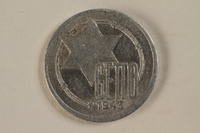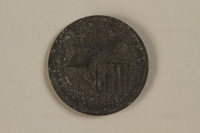Overview
- Description
- The Nachman Zonabend papers consist of biographical materials, ration tickets, and photographs documenting Zonabend’s family from Łęczyca, Poland, his confinement to the Łódź ghetto and the work he performed there, his marriage to Ita Kuperminc, his liberation, and his work as photographer and collector of historical materials for the Main Historical Commission of the Central Committee of Jews in Poland.
Biographical materials include identification papers, labor cards, and certificates documenting Zonabend’s confinement to the Łódź ghetto, the work he performed there, his marriage to Ita Kuperminc, his liberation, and his work as photographer and collector of historical materials for the Main Historical Commission of the Central Committee of Jews in Poland.
Łódź ghetto tickets include two kinds of midday meal tickets and a ticket for a streetcar that ran through the ghetto.
Photographs depict Nachman Zonabend with his family in Łęczyca, Zonabend in the Łódź ghetto with children, Pinchas (Swarc) Shaar, Ita Kuperminc, Josef Kowner, Irena Działoszyńska, and Anton Kraft in the ghetto, a meeting of the Central Jewish Historical Committee in Łódź after liberation, and Ita Kuperminc with three Soviet officers near a pile of skulls during the Soviet investigation of German war crimes at the alleged soap factory near Gdańsk. This series also includes a photograph by Mendel Grossman of a boy killed during the Gehsperre Aktion in September 1942. - Date
-
inclusive:
circa 1932-1946
- Credit Line
- United States Holocaust Memorial Museum Collection, Gift of Nachman Zonabend
- Collection Creator
- Nachman Zonabend
- Biography
-
Nachman (Natek) Zonabend (1918‐2006) was born in Łęczyca, Poland, to Abram and Malka Rosenberg Zonabend. His brothers were Tojwje, Wolf, Izak, and Noach, and his sisters were Szajna, Franka, and Bronka. His family moved to Łódź in 1936. He tried to escape to Warsaw in 1939, but he was captured by Germans, forced to walk to Pszczyna, escaped execution, returned to Łódź , and was forced into the ghetto in 1940. He worked in the ghetto post office and in a meat distribution center, and he was also involved with the underground project to establish an archives documenting Jewish life in the ghetto. He married Ita Kuperminc in January 1944. When the Łódź ghetto was liquidated in August 1944, Zonabend was left behind on a cleanup crew. He used the opportunity to slip into ghetto administrative offices to rescue the papers of Chaim Rumkowski and his administration as well as photographs, drawings, and paintings made by ghetto artists, and buried them in hiding places. He returned to the ghetto following the liberation of Łódź in January 1945 to rescue the hidden archives. He moved to Sweden in 1947. His parents and his sisters Szajna and Franka perished in the Holocaust.
Physical Details
- Genre/Form
- Photographs.
- Extent
-
3 folders
- System of Arrangement
- The Nachman Zonabend papers are arranged as a single series: I. Nachman Zonabend papers, approximately 1932-1946
Rights & Restrictions
- Conditions on Access
- There are no known restrictions on access to this material.
- Conditions on Use
- Material(s) in this collection may be protected by copyright and/or related rights. You do not require further permission from the Museum to use this material. The user is solely responsible for making a determination as to if and how the material may be used.
Keywords & Subjects
- Topical Term
- Jews--Poland--Łęczyca (Łęczyca) Jewish ghettos--Poland--Łódź. Holocaust, Jewish (1939-1945)--Poland--Łódź.
- Geographic Name
- Łódź (Poland)
- Personal Name
- Zonabend, Nachman, 1918-
- Corporate Name
- Litzmannstadt-Getto (Łódź, Poland)
Administrative Notes
- Holder of Originals
-
United States Holocaust Memorial Museum
- Legal Status
- Permanent Collection
- Provenance
- Nachman Zonabend donated the Nachman Zonabend papers to the United States Holocaust Memorial Museum in 1993 and 1999. The accession formerly cataloged as 1999.261.1 has been incorporated into this collection.
- Funding Note
- The cataloging of this collection has been supported by a grant from the Conference on Jewish Material Claims Against Germany.
- Primary Number
- 1993.143.3
- Record last modified:
- 2023-05-31 14:57:48
- This page:
- https://collections.ushmm.org/search/catalog/irn516270
Additional Resources
Download & Licensing
In-Person Research
- Available for Research
- Plan a Research Visit
-
Request in Shapell Center Reading Room
Bowie, MD
Contact Us
Also in Nachman Zonabend collection
The Nachman Zonabend papers consist of biographical materials, ration tickets, and photographs documenting Zonabend’s family from Łęczyca, Poland, his confinement to the Łódź ghetto and the work he performed there, his marriage to Ita Kuperminc, his liberation, and his work as photographer and collector of historical materials for the Main Historical Commission of the Central Committee of Jews in Poland. The collection also includes a bound volume of newspapers published in the Litzmannnstadt Ghetto and two Łódź ghetto coins.

Łódź (Litzmannstadt) ghetto scrip, 10 mark coin
Object
10 mark coin issued in the Łódź ghetto in Poland in 1943. Nazi Germany occupied Poland on September 1, 1940; Łódź was renamed Litzmannstadt and annexed to the German Reich. In February, the Germans forcibly relocated the large Jewish population into a sealed ghetto. All currency was confiscated in exchange for Quittungen [receipts] that could be exchanged only in the ghetto. The scrip and tokens were designed by the Judenrat [Jewish Council] and includes traditional Jewish symbols. The Germans closed the ghetto in the summer of 1944 by deporting the residents to concentration camps or killing centers.

Łódź (Litzmannstadt) ghetto scrip, 5 mark coin
Object
5 mark coin issued in the Łódź ghetto in Poland in 1943. Nazi Germany occupied Poland on September 1, 1940; Łódź was renamed Litzmannstadt and annexed to the German Reich. In February, the Germans forcibly relocated the large Jewish population into a sealed ghetto. All currency was confiscated in exchange for Quittungen [receipts] that could be exchanged only in the ghetto. The scrip and tokens were designed by the Judenrat [Jewish Council] and includes traditional Jewish symbols. The Germans closed the ghetto in the summer of 1944 by deporting the residents to concentration camps or killing centers.



